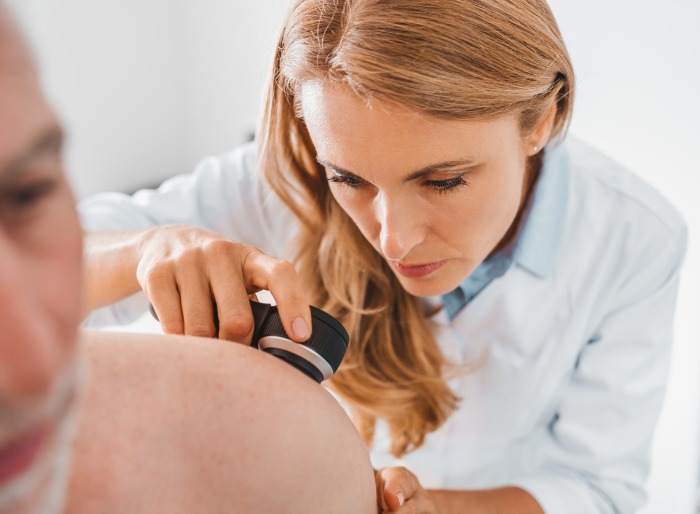Actinic keratosis is one of the most common skin conditions that our dermatologists in Gainesville, Florida treat. According to the Skin Cancer Foundation, over 58 million Americans are affected by actinic keratoses, but many do not know what they are and how they are treated. These are precancerous skin growths common in people who rarely take protection against the sun. At Dermatology Associates, our dermatologists in Gainesville have years of experience in treating actinic keratoses.
Dermatology Associates is a full-service dermatology practice providing the Gainesville community with high-quality surgical and medical dermatology services through the use of innovative techniques, consultative support, and state-of-the-art equipment. Schedule an appointment today, so you can learn more about your risk and ways to minimize them.


What Is Actinic Keratosis?
Actinic keratosis, also called solar keratosis, is a common form of precancer that forms on skin damaged by long-term exposure to ultraviolet light. If you already have actinic keratosis, you may be more prone to them in the future and at a greater risk of squamous cell carcinoma, a common form of skin cancer.
What Are The Signs & Symptoms Of Actinic Keratosis?
Actinic keratoses are small dry, scaly, or crusty patches of skin that vary in color and can either be flat or raised. They are rough in texture, making them easier to be felt than seen. One of the first signs of actinic keratoses are rough, raised bumps on your skin with a yellow or brown crust on top. Below, we have listed some common symptoms of this skin condition.
- Bleeding
- Burning, Stinging, Or Itching
- Dry, Scaly Lips
- Horn-Like Skin Growths That Stick Out
- Loss Of Color In The Lips
- Pain Or Tenderness
How Do Dermatologists Diagnose Actinic Keratosis
If you have one or more actinic keratoses, one of our Gainesville dermatologists can often diagnose these by carefully examining your skin while also looking for signs of skin cancer. If any of these look worrisome, your dermatologist may take a skin biopsy, which is a minimally invasive procedure that allows for a specific diagnosis.
How Do Dermatologists Treat Actinic Keratosis
Finding the right treatment for your actinic keratoses is dependent on a number of factors, including how many you have, where they are located, their appearance, if you have had skin cancer, and other medical conditions. Below, our dermatology specialists in Florida have outlined some ways we treat actinic keratosis.
Chemical Peel
As opposed to at-home chemical peels, these are medical-grade used to destroy the top layers of skin. After treatment, your skin will appear red and swollen and may feel sore. After the area has healed, you will have healthy, new skin!
Cryosurgery
When using cryosurgery as a treatment option, your dermatologist will freeze the actinic keratosis with liquid nitrogen, causing it to fall off after a few days. This may have to be repeated for complete resolution. This procedure is done during an office visit while you remain awake. It is normal to see crusting or a blister following treatment.
At-Home Treatment For Actinic Keratosis
If you have many actinic keratoses that you can feel but not see, at-home treatment with medication may be recommended. For this treatment to be effective, it is important to follow your dermatologist’s treatment plan.
Curettage
Curettage is used for thick actinic keratoses. During this procedure, the dermatologist will numb the skin and scrape the actinic keratosis from the skin. The provider may follow up with an electrodesiccation to destroy any remaining actinic keratosis cells.
Photodynamic Therapy
For those with recurring actinic keratoses, photodynamic therapy may be recommended. This is a multi-step procedure. First, the skin is prepared. Then, a solution is applied to the affected area, which will make your skin extremely sensitive to light. After this is applied, you will wait in the office for 60–90 minutes, and then your skin will be treated with either red or blue light. Following treatment, you will need to avoid daylight for 48 hours. Some will need a second photodynamic treatment weeks, months, or years after initial treatment.
Preventing Actinic Keratoses
To help prevent actinic keratoses, follow strict sun protection, including using a daily sunscreen with high sun protection, such as 50 SPF or higher. The following are other ways to prevent actinic keratosis.
- Limit Your Time In The Sun. Avoid time in the sun between 10 a.m. and 2 p.m. and staying in the sun so long that you get a sunburn.
- Cover-Up. For extra protection from the sun, wear tightly woven clothing that covers your arms and legs.
- Avoid Tanning Beds. The UV exposure from a tanning bed causes as much or more skin damage as a tan acquired from the sun.
- Check Your Skin Regularly. Examine your skin regularly, looking for the development of new skin growths or changes in existing moles, freckles, bumps, and birthmarks.

How Long Does It Take For Actinic Keratosis To Go Away?
How long actinic keratoses will take to disappear depends on their size and how many you have, but it can often take up to three months following treatment for them to fully disappear. Following treatment, it is important to see your healthcare provider for a checkup once or twice a year. If you have a weakened immune system, you may need to see your dermatologist four to six times per year.